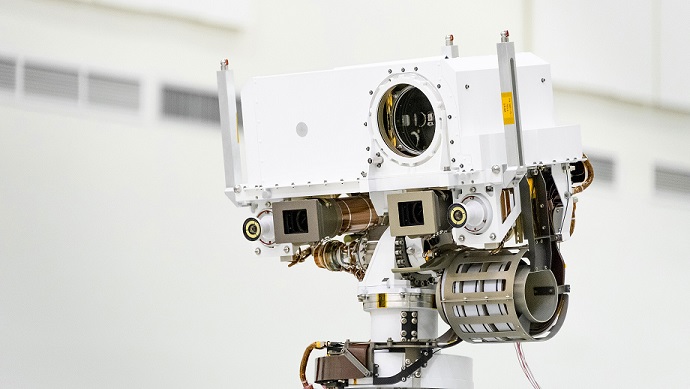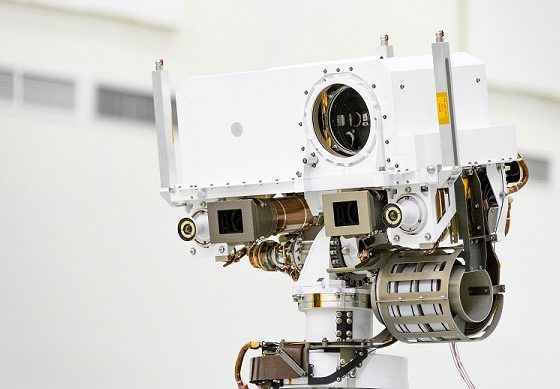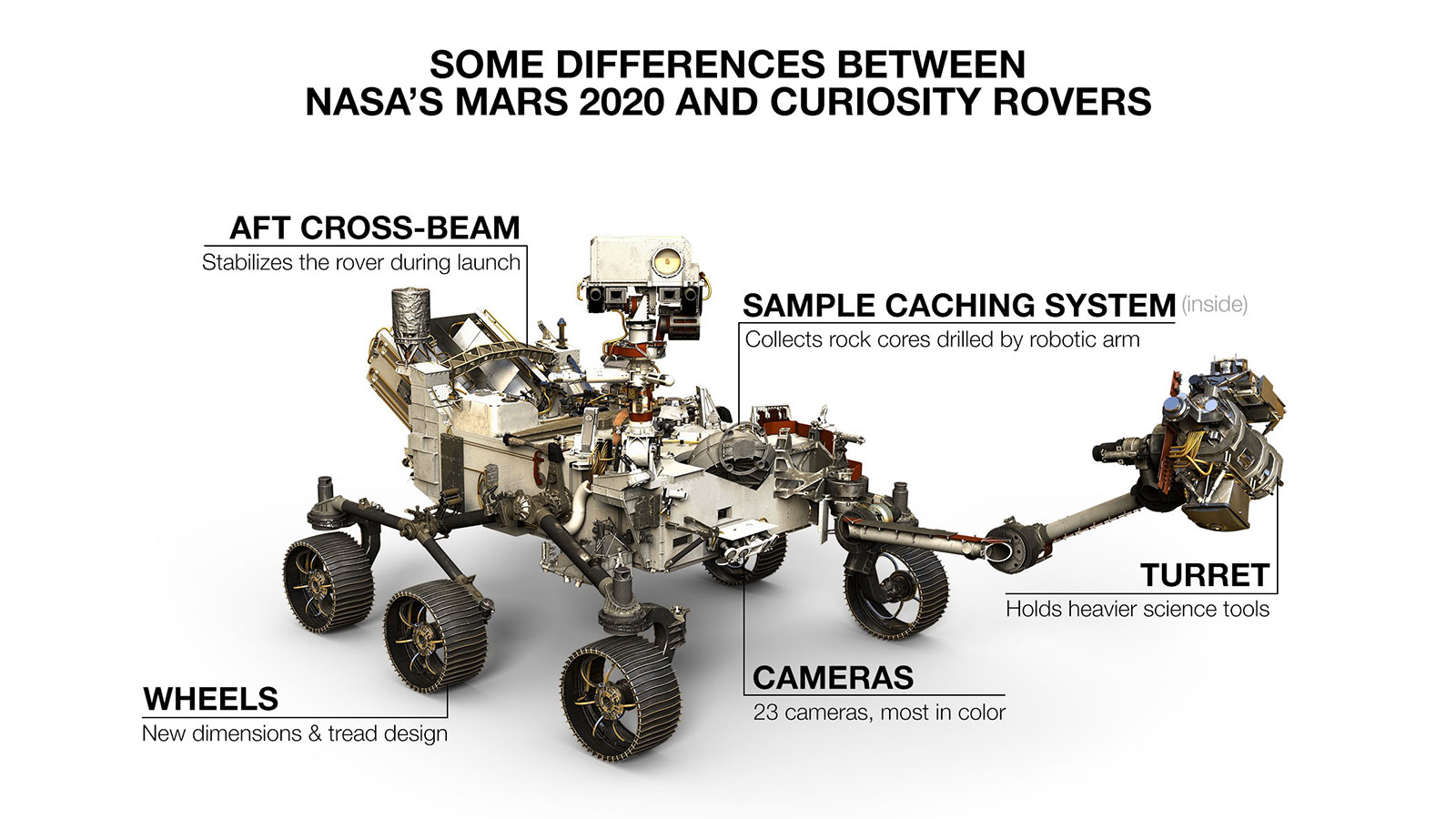

Space
NASA gears up Mars rover for perfect 20/20 ‘SuperCam’ vision ahead of mission to red planet
NASA engineers are busy preparing the agency’s next Mars rover for its upcoming journey to the red planet. The six-wheeled robot will scour the Martian surface to look for signs of life. Deemed essential by NASA’s administrator, the mission is progressing as planned in order to meet a July launch.
The Perseverance Mars rover will land on Mars in February 2021, touching down in an ancient river bed called Jezero Crater. The 28-mile-wide crater is the site of an ancient river delta, and as such, scientists believe it could harbor fossilized life. That’s because the region is home to mineral deposits like hydrated silica, which is a preservative material here on Earth.
To help it search out key mineral deposits, the rover is packing a suite of scientific instruments, including some specialized cameras. The rover was built at NASA’s Jet Propulsion Laboratory in California but was shipped to its Florida launch site earlier this year.

Since its arrival, engineers have begun reassembling the rover and preparing it for flight. It will not be flying solo to the red planet, but instead, will be accompanied by the first interplanetary helicopter. Approximately the size of a softball, the Mars helicopter has passed pre-launch testing and was recently installed on the belly of the rover.
The rover, however, still has a few more milestones to complete before its ready to be tucked into its aeroshell and loaded into the launch vehicle. To that end, the rover recently had its vision tested.
Perseverance is packing multiple cameras that have a range of imaging capabilities from wide-angle cameras capable of capturing sweeping vistas to a narrow-angle, high-resolution camera capable of zooming in on details on the Martian surface.
The rover will use the SuperCam (along with its laser and spectrometers) to examine Martian rocks and soil, looking for organic compounds that could indicate past life on Mars.
So how does one test a rover’s vision? With a giant grid of dots.

The rover’s vision was first tested back in July 2019 at the Jet Propulsion Lab and then rechecked once the cameras were installed at NASA’s Kennedy Space Center in Florida. The rover’s main camera, called the SuperCam, is installed on the rover’s head. It appears as a large circular opening, and this is the lens. Underneath it are two grey boxes that are two Mastcam-Z-imagers, and on the outside of those boxes are two more cameras used for navigation.
“We completed the machine-vision calibration of the forward-facing cameras on the rover,” Justin Maki, chief engineer for imaging and the imaging scientist for Mars 2020 at JPL, said during the test. “This measurement is critical for accurate stereo vision, which is an important capability of the vehicle.”

To calibrate the imagers, target boards that feature grids of dots were imaged and placed at distances ranging from 1 to 44 yards (1 to 40 meters) away. Those boards were used to confirm that the cameras meet the project’s requirements for resolution and geometric accuracy.
“We tested every camera on the front of the rover chassis and also those mounted on the mast,” Maki said. “Characterizing the geometric alignment of all these images is important for driving the vehicle on Mars, operating the robotic arm, and accurately targeting the rover’s laser.”
But the work isn’t done yet, the imagers on Perseverance’s body and arm will happen in the coming weeks.

News
SpaceX shades airline for seeking contract with Amazon’s Starlink rival

SpaceX employees, including its CEO Elon Musk, shaded American Airlines on social media this past weekend due to the company’s reported talks with Amazon’s Starlink rival, Leo.
Starlink has been adopted by several airlines, including United Airlines, Qatar Airways, Hawaiian Airlines, WestJet, Air France, airBaltic, and others. It has gained notoriety as an extremely solid, dependable, and reliable option for airline travel, as traditional options frequently cause users to lose connection to the internet.
Many airlines have made the switch, while others continue to mull the options available to them. American Airlines is one of them.
A report from Bloomberg indicates the airline is thinking of going with a Starlink rival owned by Amazon, called Leo. It was previously referred to as Project Kuiper.
American CEO Robert Isom said (via Bloomberg):
“While there’s Starlink, there are other low-Earth-orbit satellite opportunities that we can look at. We’re making sure that American is going to have what our customers need.”
Isom also said American has been in touch with Amazon about installing Leo on its aircraft, but he would not reveal the status of any discussions with the company.
The report caught the attention of Michael Nicolls, the Vice President of Starlink Engineering at SpaceX, who said:
“Only fly on airlines with good connectivity… and only one source of good connectivity at the moment…”
CEO Elon Musk replied to Nicolls by stating that American Airlines risks losing “a lot of customers if their connectivity solution fails.”
American Airlines will lose a lot of customers if their connectivity solution fails
— Elon Musk (@elonmusk) December 14, 2025
There are over 8,000 Starlink satellites in orbit currently, offering internet coverage in over 150 countries and territories globally. SpaceX expands its array of satellites nearly every week with launches from California and Florida, aiming to offer internet access to everyone across the globe.
Currently, the company is focusing on expanding into new markets, such as Africa and Asia.
News
Tesla hints at Starlink integration with recent patent
“By employing polymer blends, some examples enable RF transmission from all the modules to satellites and other communication devices both inside and outside the vehicle.”

Tesla hinted at a potential Starlink internet terminal integration within its vehicles in a recent patent, which describes a vehicle roof assembly with integrated radio frequency (RF) transparency.
The patent, which is Pub. No U.S. 2025/0368267 describes a new vehicle roof that is made of RF-transparent polymer materials, allowing and “facilitating clear communication with external devices and satellites.”
Tesla believes that a new vehicle roof design, comprised of different materials than the standard metallic or glass elements used in cars today, would allow the company to integrate modern vehicular technologies, “particularly those requiring radio frequency transmission and reception.
Tesla has recently filed a US patent application on integrating RF transparent materials into the roof structure.
“facilitating clear communication with external devices and satellites”
Tesla fleet is getting @Starlink connectivity integration soon. LFG @Tesla @elonmusk… pic.twitter.com/bLa8YtPLd1
— Chansoo Byeon (@Chansoo) December 9, 2025
Instead of glass or metallic materials, Tesla says vehicles may benefit from high-strength polymer blends, such as Polycarbonate, Acrylonitrile Butadiene Styrene, or Acrylonitrile Styrene Acrylate.
These materials still provide ideal strength metrics for crashworthiness, stiffness for noise, vibration, and harshness control, and are compliant with head impact regulations.
They would also enable better performance with modern technologies, like internet terminals, which need an uninterrupted signal to satellites for maximum reception. Tesla writes in the patent:
“By employing polymer blends, some examples enable RF transmission from all the modules to satellites and other communication devices both inside and outside the vehicle.”

One of the challenges Tesla seems to be aware of with this type of roof design is the fact that it will still have to enable safety and keep that at the forefront of the design. As you can see in the illustration above, Tesla plans to use four layers to increase safety and rigidity, while also combating noise and vibration.
It notes in the patent that disclosed examples still meet the safety requirements outlined in the Federal Motor Vehicle Safety Standards (FMVSS).
Starlink integrated directly into Tesla vehicles would be a considerable advantage for owners. It would come with a handful of distinct advantages.
Initially, the inclusion of Starlink would completely eliminate cellular dead zones, something that is an issue, especially in rural areas. Starlink would provide connectivity in these remote regions and would ensure uninterrupted service during road trips and off-grid adventures.
It could also be a critical addition for Robotaxi, as it is crucial to have solid and reliable connectivity for remote monitoring and fleet management.
Starlink’s growing constellation, thanks to SpaceX’s routine and frequent launch schedule, will provide secure, stable, and reliable internet connectivity for Tesla vehicles.
Although many owners have already mounted Starlink Mini dishes under their glass roofs for a similar experience, it may be integrated directly into Teslas in the coming years, either as an upgrade or a standard feature.
Investor's Corner
SpaceX IPO is coming, CEO Elon Musk confirms
However, it appears Musk is ready for SpaceX to go public, as Ars Technica Senior Space Editor Eric Berger wrote an op-ed that indicated he thought SpaceX would go public soon. Musk replied, basically confirming it.

Elon Musk confirmed through a post on X that a SpaceX initial public offering (IPO) is on the way after hinting at it several times earlier this year.
It also comes one day after Bloomberg reported that SpaceX was aiming for a valuation of $1.5 trillion, adding that it wanted to raise $30 billion.
Musk has been transparent for most of the year that he wanted to try to figure out a way to get Tesla shareholders to invest in SpaceX, giving them access to the stock.
He has also recognized the issues of having a public stock, like litigation exposure, quarterly reporting pressures, and other inconveniences.
However, it appears Musk is ready for SpaceX to go public, as Ars Technica Senior Space Editor Eric Berger wrote an op-ed that indicated he thought SpaceX would go public soon.
Musk replied, basically confirming it:
As usual, Eric is accurate
— Elon Musk (@elonmusk) December 10, 2025
Berger believes the IPO would help support the need for $30 billion or more in capital needed to fund AI integration projects, such as space-based data centers and lunar satellite factories. Musk confirmed recently that SpaceX “will be doing” data centers in orbit.
AI appears to be a “key part” of SpaceX getting to Musk, Berger also wrote. When writing about whether or not Optimus is a viable project and product for the company, he says that none of that matters. Musk thinks it is, and that’s all that matters.
It seems like Musk has certainly mulled something this big for a very long time, and the idea of taking SpaceX public is not just likely; it is necessary for the company to get to Mars.
The details of when SpaceX will finally hit that public status are not known. Many of the reports that came out over the past few days indicate it would happen in 2026, so sooner rather than later.
But there are a lot of things on Musk’s plate early next year, especially with Cybercab production, the potential launch of Unsupervised Full Self-Driving, and the Roadster unveiling, all planned for Q1.








